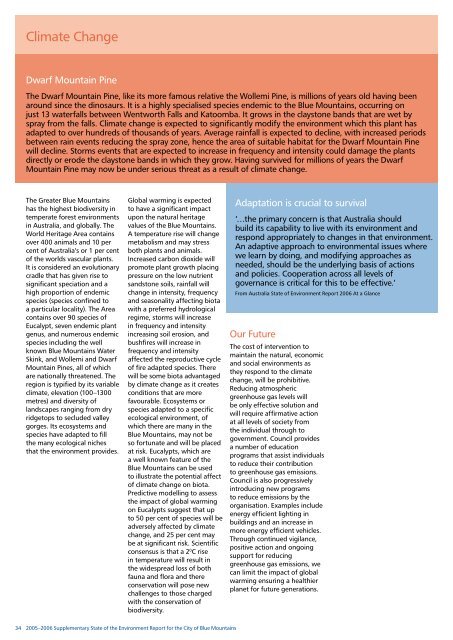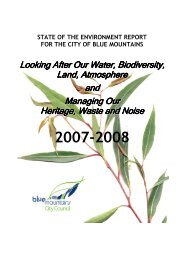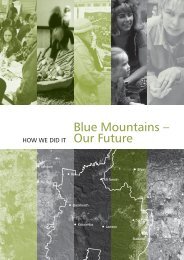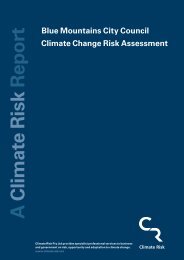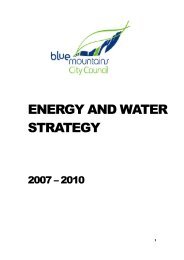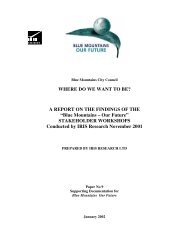State of the Environment Report for the City of Blue Mountains
State of the Environment Report for the City of Blue Mountains
State of the Environment Report for the City of Blue Mountains
You also want an ePaper? Increase the reach of your titles
YUMPU automatically turns print PDFs into web optimized ePapers that Google loves.
Climate Change<br />
Dwarf Mountain Pine<br />
The Dwarf Mountain Pine, like its more famous relative <strong>the</strong> Wollemi Pine, is millions <strong>of</strong> years old having been<br />
around since <strong>the</strong> dinosaurs. It is a highly specialised species endemic to <strong>the</strong> <strong>Blue</strong> <strong>Mountains</strong>, occurring on<br />
just 13 waterfalls between Wentworth Falls and Katoomba. It grows in <strong>the</strong> claystone bands that are wet by<br />
spray from <strong>the</strong> falls. Climate change is expected to significantly modify <strong>the</strong> environment which this plant has<br />
adapted to over hundreds <strong>of</strong> thousands <strong>of</strong> years. Average rainfall is expected to decline, with increased periods<br />
between rain events reducing <strong>the</strong> spray zone, hence <strong>the</strong> area <strong>of</strong> suitable habitat <strong>for</strong> <strong>the</strong> Dwarf Mountain Pine<br />
will decline. Storms events that are expected to increase in frequency and intensity could damage <strong>the</strong> plants<br />
directly or erode <strong>the</strong> claystone bands in which <strong>the</strong>y grow. Having survived <strong>for</strong> millions <strong>of</strong> years <strong>the</strong> Dwarf<br />
Mountain Pine may now be under serious threat as a result <strong>of</strong> climate change.<br />
The Greater <strong>Blue</strong> <strong>Mountains</strong><br />
has <strong>the</strong> highest biodiversity in<br />
temperate <strong>for</strong>est environments<br />
in Australia, and globally. The<br />
World Heritage Area contains<br />
over 400 animals and 10 per<br />
cent <strong>of</strong> Australia’s or 1 per cent<br />
<strong>of</strong> <strong>the</strong> worlds vascular plants.<br />
It is considered an evolutionary<br />
cradle that has given rise to<br />
significant speciation and a<br />
high proportion <strong>of</strong> endemic<br />
species (species confined to<br />
a particular locality). The Area<br />
contains over 90 species <strong>of</strong><br />
Eucalypt, seven endemic plant<br />
genus, and numerous endemic<br />
species including <strong>the</strong> well<br />
known <strong>Blue</strong> <strong>Mountains</strong> Water<br />
Skink, and Wollemi and Dwarf<br />
Mountain Pines, all <strong>of</strong> which<br />
are nationally threatened. The<br />
region is typified by its variable<br />
climate, elevation (100–1300<br />
metres) and diversity <strong>of</strong><br />
landscapes ranging from dry<br />
ridgetops to secluded valley<br />
gorges. Its ecosystems and<br />
species have adapted to fill<br />
<strong>the</strong> many ecological niches<br />
that <strong>the</strong> environment provides.<br />
Global warming is expected<br />
to have a significant impact<br />
upon <strong>the</strong> natural heritage<br />
values <strong>of</strong> <strong>the</strong> <strong>Blue</strong> <strong>Mountains</strong>.<br />
A temperature rise will change<br />
metabolism and may stress<br />
both plants and animals.<br />
Increased carbon dioxide will<br />
promote plant growth placing<br />
pressure on <strong>the</strong> low nutrient<br />
sandstone soils, rainfall will<br />
change in intensity, frequency<br />
and seasonality affecting biota<br />
with a preferred hydrological<br />
regime, storms will increase<br />
in frequency and intensity<br />
increasing soil erosion, and<br />
bushfires will increase in<br />
frequency and intensity<br />
affected <strong>the</strong> reproductive cycle<br />
<strong>of</strong> fire adapted species. There<br />
will be some biota advantaged<br />
by climate change as it creates<br />
conditions that are more<br />
favourable. Ecosystems or<br />
species adapted to a specific<br />
ecological environment, <strong>of</strong><br />
which <strong>the</strong>re are many in <strong>the</strong><br />
<strong>Blue</strong> <strong>Mountains</strong>, may not be<br />
so <strong>for</strong>tunate and will be placed<br />
at risk. Eucalypts, which are<br />
a well known feature <strong>of</strong> <strong>the</strong><br />
<strong>Blue</strong> <strong>Mountains</strong> can be used<br />
to illustrate <strong>the</strong> potential affect<br />
<strong>of</strong> climate change on biota.<br />
Predictive modelling to assess<br />
<strong>the</strong> impact <strong>of</strong> global warming<br />
on Eucalypts suggest that up<br />
to 50 per cent <strong>of</strong> species will be<br />
adversely affected by climate<br />
change, and 25 per cent may<br />
be at significant risk. Scientific<br />
consensus is that a 2 0 C rise<br />
in temperature will result in<br />
<strong>the</strong> widespread loss <strong>of</strong> both<br />
fauna and flora and <strong>the</strong>re<br />
conservation will pose new<br />
challenges to those charged<br />
with <strong>the</strong> conservation <strong>of</strong><br />
biodiversity.<br />
Adaptation is crucial to survival<br />
‘…<strong>the</strong> primary concern is that Australia should<br />
build its capability to live with its environment and<br />
respond appropriately to changes in that environment.<br />
An adaptive approach to environmental issues where<br />
we learn by doing, and modifying approaches as<br />
needed, should be <strong>the</strong> underlying basis <strong>of</strong> actions<br />
and policies. Cooperation across all levels <strong>of</strong><br />
governance is critical <strong>for</strong> this to be effective.’<br />
From Australia <strong>State</strong> <strong>of</strong> <strong>Environment</strong> <strong>Report</strong> 2006 At a Glance<br />
Our Future<br />
The cost <strong>of</strong> intervention to<br />
maintain <strong>the</strong> natural, economic<br />
and social environments as<br />
<strong>the</strong>y respond to <strong>the</strong> climate<br />
change, will be prohibitive.<br />
Reducing atmospheric<br />
greenhouse gas levels will<br />
be only effective solution and<br />
will require affirmative action<br />
at all levels <strong>of</strong> society from<br />
<strong>the</strong> individual through to<br />
government. Council provides<br />
a number <strong>of</strong> education<br />
programs that assist individuals<br />
to reduce <strong>the</strong>ir contribution<br />
to greenhouse gas emissions.<br />
Council is also progressively<br />
introducing new programs<br />
to reduce emissions by <strong>the</strong><br />
organisation. Examples include<br />
energy efficient lighting in<br />
buildings and an increase in<br />
more energy efficient vehicles.<br />
Through continued vigilance,<br />
positive action and ongoing<br />
support <strong>for</strong> reducing<br />
greenhouse gas emissions, we<br />
can limit <strong>the</strong> impact <strong>of</strong> global<br />
warming ensuring a healthier<br />
planet <strong>for</strong> future generations.<br />
34<br />
2005–2006 Supplementary <strong>State</strong> <strong>of</strong> <strong>the</strong> <strong>Environment</strong> <strong>Report</strong> <strong>for</strong> <strong>the</strong> <strong>City</strong> <strong>of</strong> <strong>Blue</strong> <strong>Mountains</strong>


